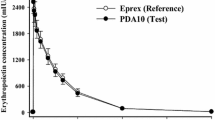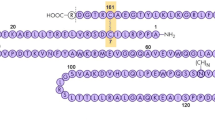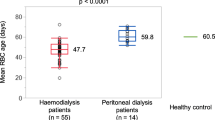Abstract
Erythropoietin (EPO) is a glycoprotein hormone produced primarily in the kidneys and to a lesser extent in the liver that regulates red cell production. Most of the studies conducted in experimental animals to assess the role of EPO in the regulation of erythropoiesis were performed in mouse models. However, little is known about the in vivo metabolism of the hormone in this species. The present study was thus undertaken to measure the plasma t 1/2 of radiolabeled recombinant human EPO (rh-EPO) in normal mice as well as in mice with altered erythrocyte production rates (EPR), plasma EPO (pEPO) titer, marrow responsiveness, red cell volume, or liver function. Adult CF-1 mice of both sexes were used throughout. For the EPO life-span studies, 30 mice in each experiment were intravenously injected with 600,000 cpm of 125I-rh-EPO and bled by cardiac puncture in groups of five every hour for 6 h. Trichloroacetic acid (TCA) was added to each plasma sample and the radioactivity in the precipitate measured in a γ-counter. EPO, pEPO, marrow responsiveness, or red cell volume were altered by either injections of rh-EPO, 5-fluorouracil, or phenylhydrazine, or by bleeding, or red cell transfusion. Liver function was altered by Cl4C administration. In the normal groups of mice, the estimated t 1/2 was 182.75 ± 14.4 (SEM) min. The estimated t 1/2 of the other experimental groups was not significantly different from normal. These results, therefore, strongly suggest that the clearance rate of EPO in mice is not subjected to physiologic regulation and that pEPO titer can be really taken as the reflection of the EPO production rate, at least in the experimental conditions reported here.
Similar content being viewed by others
References
Jelkmann, W. (1994). Clin. Invest. 72, S3-S10.
Reissmann, K. R., Diederich, D. A., Ito, K., and Schmaus, J. W. (1965). J. Lab. Clin. Med. 65, 967–975.
Bozzini, C. E. (1966). Nature 209, 1140, 1141.
Spivak, J. L. and Hogans, B. B. (1989). Blood 73, 90–99.
Naets, J. P. and Wittek, M. (1969). Am. J. Physiol. 217, 297–301.
Emmanouel, D. S., Goldwasser, E., and Katz, A. I. (1984). Am. J. Physiol. 247, F168-F176.
Piroso, E., Erslev, A. J., Flaharty, K. K., and Caro, J. (1991). Am. J. Hematol. 36, 105–110.
Bozzini, C. E. (1966). Acta Physiol. Latinoam. 16, 313–317.
Kinoshita, H., Ohishi, N., Kato, M., Tokura, S., and Okazaki, A. (1991). Arzneim-Forsch./Drug Res. 41, 1004–1007.
Mufson, R. A. and Gesner, T. G. (1987). Blood 69, 1485–1492.
Sawada, K., Krantz, S. B., Sawher, S. T., and Civin, C. I. (1988). J. Cell. Physiol. 137, 337–345.
Widness, J. A., Kisthard, J. A., Veng-Pederson, P., Peters, C., Pereira, L. M., Schmidt, R. L., et al. (1994). Exp. Hematol. 22, 704 (abstract).
Rosse, W. F. and Waldmann, T. A. (1964). J. Clin. Invest. 43, 1348–1354.
Flaharty, K. K., Caro, J., Erslev, A., Walen, J. J., Morris, E. M., Bjornsson, T. D., et al. (1990). Clin. Pharmacol. Ther. 47, 557–562.
Kindler, J., Eckardt, K. U., Ehmer, B., Jandeleit, K., and Kurtz, A. (1989). Nephrol. Dial. Transplant. 4, 345–351.
Alippi, R. M., Boyer, P., Leal, T., Barceló, A. C., Martínez, M. P., and Bozzini, C. E. (1992). Haematologica 77, 446–449.
Bozzini, C. E., Barrio Rendo, M. E., Devoto, F. C. H., and Epper, C. E. (1970). Am. J. Physiol. 219, 724–728.
Author information
Authors and Affiliations
Corresponding author
Rights and permissions
About this article
Cite this article
Lezón, C.E., Martínez, M.P., Conti, M.I. et al. Plasma disappearance of exogenous erythropoietin in mice under different experimental conditions. Endocr 8, 331–333 (1998). https://doi.org/10.1385/ENDO:8:3:331
Received:
Revised:
Accepted:
Issue Date:
DOI: https://doi.org/10.1385/ENDO:8:3:331




